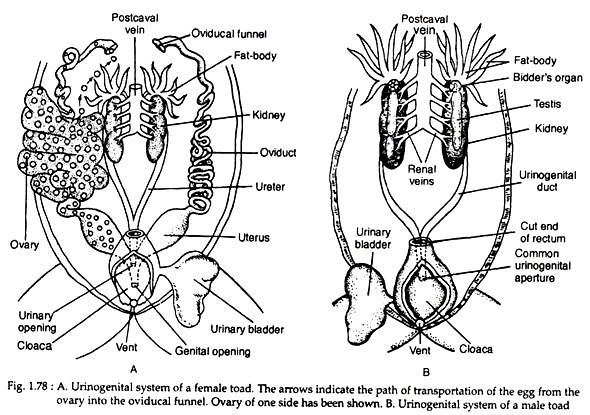In this article we will discuss about the excretory system of toad.
During metabolism various nitrogenous waste products are formed in the body. The process concerning the extraction of nitrogenous waste products and their removal from the body is called excretion. Nitrogenous waste products such as urea, uric acid and excess of water with some salts are excreted as urine.
The organs responsible for this function are:
(1) A pair of kidneys,
ADVERTISEMENTS:
(2) A pair of ureters,
(3) An urinary bladder,
(4) The cloaca, and
(5) The vent.
ADVERTISEMENTS:
The kidneys are two in number. Each kidney has a compact elongated structure and is attached to the dorsal side of the body wall. These are retroperitoneal in position, i.e., not enclosed within the peritoneum. The kidneys are of mesonephric type. The edges of the kidneys are marked by notches (Fig. 1.78).
Each kidney is composed of innumerable microscopic uriniferous tubules (or nephrons). Each uriniferous tubule has a proximal two walled cup-like structure known as Bowman’s capsule. A small afferent vessel from the renal artery enters into the capsule and breaks up into a network of capillaries to form the glomerulus.
From the glomerulus an efferent vessel emerges out and pours the blood into the renal vein. The Bowman’s capsule together with the glomerulus constitutes the Malpighian body (or renal corpuscle). The other end of the Bowman’s capsule is communicated with the tubule which is supplied by capillaries from renal portal vein.
ADVERTISEMENTS:
These tubules open into the collecting tubules which in turn open into the ureter. Numerous minute openings called nephrostomes are present on the ventral side of the kidneys. The ureters unite posteriorly to form a common duct which opens into the cloaca.
A bilobed urinary bladder opens into the ventral side of the cloaca. The bilobed urinary bladder is formed by the fusion of two urinary bladders. Other excretory products are carbon dioxide and water formed as by-product of internal respiration. They are eliminated by lungs and skin.
